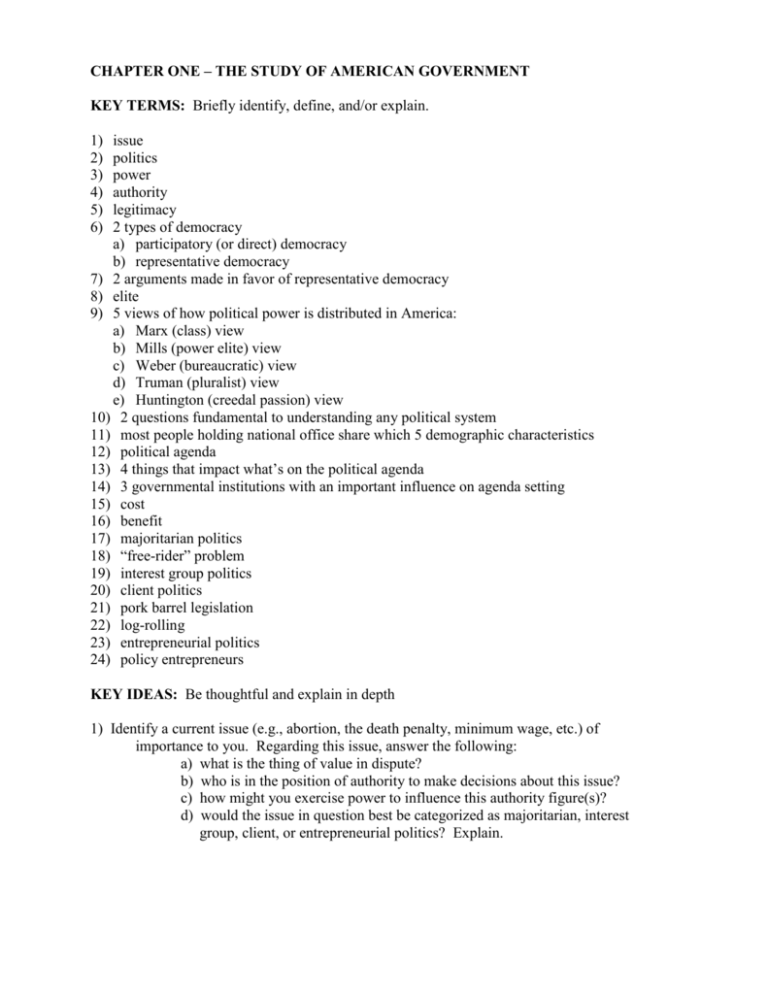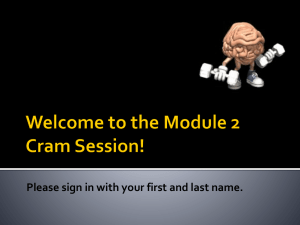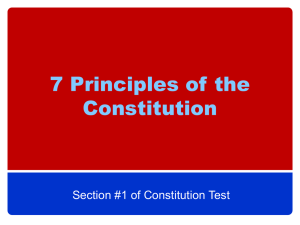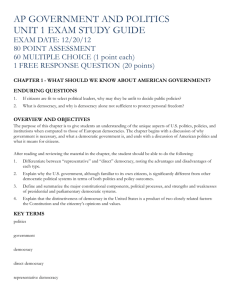Unit One Homework
advertisement

CHAPTER ONE – THE STUDY OF AMERICAN GOVERNMENT KEY TERMS: Briefly identify, define, and/or explain. 1) 2) 3) 4) 5) 6) issue politics power authority legitimacy 2 types of democracy a) participatory (or direct) democracy b) representative democracy 7) 2 arguments made in favor of representative democracy 8) elite 9) 5 views of how political power is distributed in America: a) Marx (class) view b) Mills (power elite) view c) Weber (bureaucratic) view d) Truman (pluralist) view e) Huntington (creedal passion) view 10) 2 questions fundamental to understanding any political system 11) most people holding national office share which 5 demographic characteristics 12) political agenda 13) 4 things that impact what’s on the political agenda 14) 3 governmental institutions with an important influence on agenda setting 15) cost 16) benefit 17) majoritarian politics 18) “free-rider” problem 19) interest group politics 20) client politics 21) pork barrel legislation 22) log-rolling 23) entrepreneurial politics 24) policy entrepreneurs KEY IDEAS: Be thoughtful and explain in depth 1) Identify a current issue (e.g., abortion, the death penalty, minimum wage, etc.) of importance to you. Regarding this issue, answer the following: a) what is the thing of value in dispute? b) who is in the position of authority to make decisions about this issue? c) how might you exercise power to influence this authority figure(s)? d) would the issue in question best be categorized as majoritarian, interest group, client, or entrepreneurial politics? Explain. CHAPTER TWO – THE CONSTITUTION KEY TERMS: Briefly identify, define, and/or explain. 1) differences in the goals of the American, French, & Russian Revolutions 2) makeup of the English Constitution 3) why the English Constitution was not an adequate guarantee of American liberty 4) 3 essential rights of man 5) the “real” revolution 6) Articles of Confederation 7) weaknesses of the A of C (list at least 5) 8) advertised purpose of the convention at Philadelphia 9) problem of the Pennsylvania Constitution 10) Shays Rebellion 11) Jefferson’s “tree of liberty” quote 12) state which boycotted the Philadelphia Convention 13) 4 famous men absent from Philadelphia 14) 4 key men who were present in Philadelphia 15) influence of John Locke on the Constitution 16) the liberty v. order dilemma 17) Virginia Plan 18) New Jersey Plan 19) Great (or Connecticut) Compromise 20) other compromises included in the Constitution 21) why the Framers favored a republic over a direct democracy 22) judicial review 23) methods for amending the Constitution 24) two major principles of American representative democracy 25) enumerated powers 26) reserved powers 27) concurrent powers 28) check & balances (box on p. 34) 29) faction 30) Federalists v. Anti-Federalists 31) ratification procedure 32) central objection of Anti-Federalists to the Constitution 33) Madison on the desirability of a large republic 34) reasons why there was no Bill of Rights in the original Constitution 35) author of the Bill of Rights 36) why the Constitution did not attack slavery 37) 3 ways in which the Constitution did deal with slavery 38) Beard thesis on the motives of the Framers 39) arguments against Beard’s thesis 40) the Framers view of “inequality” v. a more modern view 41) arguments for reducing the separation of powers 42) arguments for making the system less democratic 43) line-item veto KEY IDEAS: Be thoughtful and explain in depth. 1) Discuss the liberty v. order dilemma of government in reference to each of the following: a) British rule of the colonies, b) government under the Articles of Confederation, c) debates between Federalists and Anti-Federalists over ratification of the Constitution. 2) Separation of Powers and Federalism are two key features of the American system, however, together they serve to make government both less democratic and less efficient. Explain why these principles were included in the Constitution by the Framers? 3) Were women left out of the Constitution? Explain. (see box on p. 44) CHAPTER THREE – FEDERALISM KEY TERMS: Briefly identify, define, and/or explain. 1) Federalism 2) 10th Amendment 3) unitary, federal & confederal systems (see Fig. 3.1 on p. 54 & box on p. 60) 4) Hamilton v. Jefferson on national power 5) John Marshall’s decision in McCulloch v. Maryland (1819) 6) nullification doctrine 7) dual federalism 8) police power 9) difference between a federal system and a unitary one 10) how federalism struggled in the case of Hurricane Katrina 11) most obvious effect of federalism 12) initiative 13) referendum 14) recall 15) grants-in-aid 16) reasons why federal money is so attractive to state officials 17) intergovernmental lobby 18) categorical grants 19) block grants 20) conditions of aid 21) mandates 22) waiver 23) devolution KEY IDEAS: Be thoughtful and explain in depth. 1) Using a specific example to illustrate, explain how the federal government in Washington, D.C. uses money to control what goes on at the state and local levels. 2) The U.S. became the first truly federal government in the world when the Constitution went into effect in 1789. In your opinion, in comparison to a unitary or confederal system, is federalism a good or a bad thing? Explain your answer.










